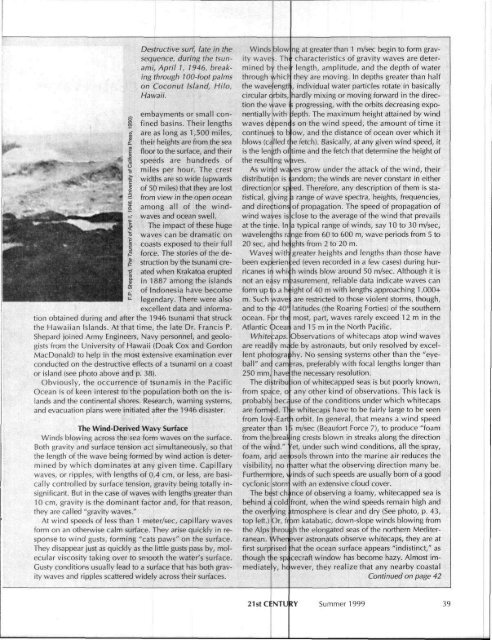Back to the Moon with Nuclear Rockets
Back to the Moon with Nuclear Rockets
Back to the Moon with Nuclear Rockets
- No tags were found...
Create successful ePaper yourself
Turn your PDF publications into a flip-book with our unique Google optimized e-Paper software.
Destructive surf, late in <strong>the</strong>sequence, during <strong>the</strong> tsunami,April 7, 1946, breakingthrough 100-foot palmson Coconut Island, Hilo,Hawaii.embayments or small con-: fined basins. Their lengths; are as long as 1,500 miles,<strong>the</strong>ir heights are from <strong>the</strong> seafloor <strong>to</strong> <strong>the</strong> surface, and <strong>the</strong>irspeeds are hundreds ofmiles per hour. The crest[ widths are so wide (upwardsof 50 miles) that <strong>the</strong>y are lost• from view in <strong>the</strong> open oceanamong all of <strong>the</strong> wind-• waves and ocean swell.i The impact of <strong>the</strong>se hugewaves can be dramatic onI coasts exposed <strong>to</strong> <strong>the</strong>ir full: force. The s<strong>to</strong>ries of <strong>the</strong> destructionby <strong>the</strong> tsunami createdwhen Kraka<strong>to</strong>a erupted! in 1887 among <strong>the</strong> islands! of Indonesia have becomelegendary. There were alsoexcellent data and informationobtained during and after <strong>the</strong> 1946 tsunami that struck<strong>the</strong> Hawaiian Islands. At that time, <strong>the</strong> late Dr. Francis P.Shepard joined Army Engineers, Navy personnel, and geologistsfrom <strong>the</strong> University of Hawaii (Doak Cox and GordonMacDonald) <strong>to</strong> help in <strong>the</strong> most extensive examination everconducted on <strong>the</strong> destructive effects of a tsunami on a coas<strong>to</strong>r island (see pho<strong>to</strong> above and p. 38).Obviously, <strong>the</strong> occurrence of tsunamis in <strong>the</strong> PacificOcean is of keen interest <strong>to</strong> <strong>the</strong> population both on <strong>the</strong> islandsand <strong>the</strong> continental shores. Research, warning systems,and evacuation plans were initiated after <strong>the</strong> 1946 disaster.The Wind-Derived Wavy SurfaceWinds blowing across <strong>the</strong> sea form waves on <strong>the</strong> surface.Both gravity and surface tension act simultaneously, so that<strong>the</strong> length of <strong>the</strong> wave being formed by wind action is determinedby which dominates at any given time. Capillarywaves, or ripples, <strong>with</strong> lengths of 0.4 cm, or less, are basicallycontrolled by surface tension, gravity being <strong>to</strong>tally insignificant.But in <strong>the</strong> case of waves <strong>with</strong> lengths greater than10 cm, gravity is <strong>the</strong> dominant fac<strong>to</strong>r and, for that reason,<strong>the</strong>y are called "gravity waves."At wind speeds of less than 1 meter/sec, capillary wavesform on an o<strong>the</strong>rwise calm surface. They arise quickly in response<strong>to</strong> wind gusts, forming "cats paws" on <strong>the</strong> surface.They disappear just as quickly as <strong>the</strong> little gusts pass by, molecularviscosity taking over <strong>to</strong> smooth <strong>the</strong> water's surface.Gusty conditions usually lead <strong>to</strong> a surface that has both gravitywaves and ripples scattered widely across <strong>the</strong>ir surfaces.Winds blow ng at greater than 1 m/sec begin <strong>to</strong> form gravitywaves. Th< characteristics of gravity waves are determinedby <strong>the</strong>i' length, amplitude, and <strong>the</strong> depth of waterthrough whicr <strong>the</strong>y are moving. In depths greater than half<strong>the</strong> wavelengtl, individual water particles rotate in basicallycircular orbits, hardly mixing or moving forward in <strong>the</strong> direction<strong>the</strong> wave i; progressing, <strong>with</strong> <strong>the</strong> orbits decreasing exponentially<strong>with</strong> iepth. The maximum height attained by windwaves depenc s on <strong>the</strong> wind speed, <strong>the</strong> amount of time itcontinues <strong>to</strong> b ow, and <strong>the</strong> distance of ocean over which itblows (called t ie fetch). Basically, at any given wind speed, itis <strong>the</strong> length of time and <strong>the</strong> fetch that determine <strong>the</strong> height of<strong>the</strong> resulting wives.As wind wa/es grow under <strong>the</strong> attack of <strong>the</strong> wind, <strong>the</strong>irdistribution is landom; <strong>the</strong> winds are never constant in ei<strong>the</strong>rdirection or sp;ed. Therefore, any description of <strong>the</strong>m is statistical,giving i range of wave spectra, heights, frequencies,and directions of propagation. The speed of propagation ofwind waves is close <strong>to</strong> <strong>the</strong> average of <strong>the</strong> wind that prevailsat <strong>the</strong> time. In a typical range of winds, say 10 <strong>to</strong> 30 m/sec,wavelengths n nge from 60 <strong>to</strong> 600 m, wave periods from 5 <strong>to</strong>20 sec, and he ghts from 2 <strong>to</strong> 20 m.Waves <strong>with</strong> greater heights and lengths than those havebeen experien :ed (even recorded in a few cases) during hurricanesin which winds blow around 50 m/sec. Although it isnot an easy m ^asurement, reliable data indicate waves canform up <strong>to</strong> a hi 'ight of 40 m <strong>with</strong> lengths approaching 1,000+m. Such wave are restricted <strong>to</strong> those violent s<strong>to</strong>rms, though,and <strong>to</strong> <strong>the</strong> 40 c latitudes (<strong>the</strong> Roaring Forties) of <strong>the</strong> sou<strong>the</strong>rnocean. For <strong>the</strong> most, part, waves rarely exceed 12 m in <strong>the</strong>Atlantic Ocear and 15 m in <strong>the</strong> North Pacific.Whitecaps. Observations of whitecaps a<strong>to</strong>p wind wavesare readily m^de by astronauts, but only resolved by excellentpho<strong>to</strong>graphy. No sensing systems o<strong>the</strong>r than <strong>the</strong> "eyeball"and cameras, preferably <strong>with</strong> focal lengths longer than250 mm, have <strong>the</strong> necessary resolution.The distribu ion of whitecapped seas is but poorly known,from space, o • any o<strong>the</strong>r kind of observations. This lack isprobably becc use of <strong>the</strong> conditions under which whitecapsare formed. Tl e whitecaps have <strong>to</strong> be fairly large <strong>to</strong> be seenfrom low-Earti orbit. In general, that means a wind speedgreater than 1 5 m/sec (Beaufort Force 7), <strong>to</strong> produce "foamfrom <strong>the</strong> breal ing crests blown in streaks along <strong>the</strong> directionof <strong>the</strong> wind." 'et, under such wind conditions, all <strong>the</strong> spray,foam, and aeiosols thrown in<strong>to</strong> <strong>the</strong> marine air reduces <strong>the</strong>visibility, no r latter what <strong>the</strong> observing direction many be.Fur<strong>the</strong>rmore, \ rinds of such speeds are usually born of a goodcyclonic s<strong>to</strong>m <strong>with</strong> an extensive cloud cover.The best ch ince of observing a foamy, whitecapped sea isbehind a cold front, when <strong>the</strong> wind speeds remain high and<strong>the</strong> overlying itmosphere is clear and dry (See pho<strong>to</strong>, p. 43,<strong>to</strong>p left.) Or, ft am katabatic, down-slope winds blowing from<strong>the</strong> Alps throu ^h <strong>the</strong> elongated seas of <strong>the</strong> nor<strong>the</strong>rn Mediterranean.Wher ever astronauts observe whitecaps, <strong>the</strong>y are atfirst surprised :hat <strong>the</strong> ocean surface appears "indistinct," asthough <strong>the</strong> sp; cecraft window has become hazy. Almost immediately,he wever, <strong>the</strong>y realize that any nearby coastalContinued on page 4221st CENTURY Summer 1999 39
















